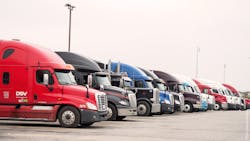In December last year, truck stop chain Pilot Flying J (PFJ) launched its myPilot app in partnership with Sensys Networks to help provide real-time data on truck parking availability. The chain launched it after 18 months of testing at 30 PFJ locations along the I-5 north/south highway corridor from San Diego, CA, up to Seattle, WA, and one facility in Knoxville, TN – using sensor systems embedded in the asphalt to collect and feed real-time parking availability data to drivers via the app.
Now, Tyler Tanaka, PFJ’s director of digital and innovation, said analysis of the parking data captured by the app indicates that more efficient use of available parking spaces for trucks may be more critical than adding more overall slots.
“The feedback we’re getting is that it’s not necessarily more parking that is the issue,” he explained to Fleet Owner in an interview at the Mid America Trucking Show. “It’s really about getting more accurate parking information so they [truck drivers] can make better decisions. It’s dealing with the issue of finding parking and the [electronic logging device] clock; that’s leading to a real loss of mileage [as] drivers are getting off the road earlier to secure parking spaces.”
That’s why Tanaka said the partnership with Sensys and its patented sensor technology is so critical; it is a partnership that “leverages technology to alleviate stress and remove anxiety” among drivers about finding parking.
“The accuracy of the data is what really matters,” he noted. “We chose a product that sits in the ground and delivers occupancy/vacancy status for parking slots in real time, via either our mobile application or website. It addresses a real pain among drivers: ‘I don’t know where to stop, therefore I can’t plan my day.’”
None of that means, though, that adding more parking spaces along the nation’s highway wouldn’t be welcome. There are an estimated 3 million truckers on U.S. roads and highways yet only about 300,000 public parking spots, and Tanaka noted PFJ’s total national parking “footprint” numbers about 75,000 spaces in total.
Going forward, he said PFJ isn’t planning to roll out its real-time parking space tracking system to every truck stop in its network. Rather, the company is planning to focus on key “corridors” like I-5 where freight volumes are particularly heavy.
“We know the I-95 corridor in the Northeast is problematic in terms of [truck] parking,” Tanaka noted. “Also major urban centers like Atlanta and Chicago suffer parking shortages as well. So it is specifically where the parking shortage is most severe along such corridors and in such cities that we need to target our technology. Because the freight model is also changing; there is a lot more ‘last mile’ and urban distribution occurring. That’s going to drive our decision about where to deploy this technology next.”
About the Author
Sean Kilcarr
Editor in Chief
Sean Kilcarr is a former longtime FleetOwner senior editor who wrote for the publication from 2000 to 2018. He served as editor-in-chief from 2017 to 2018.
